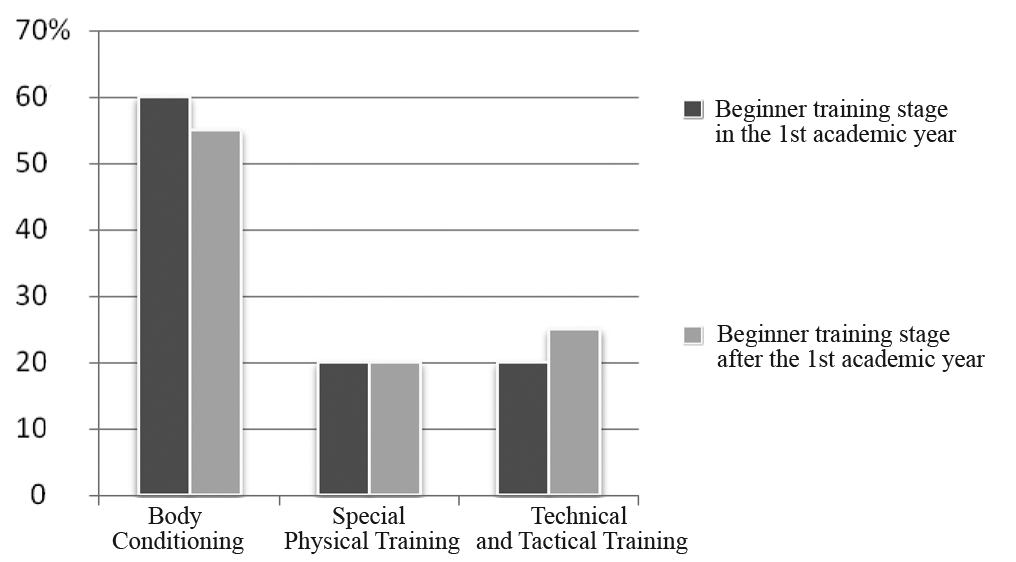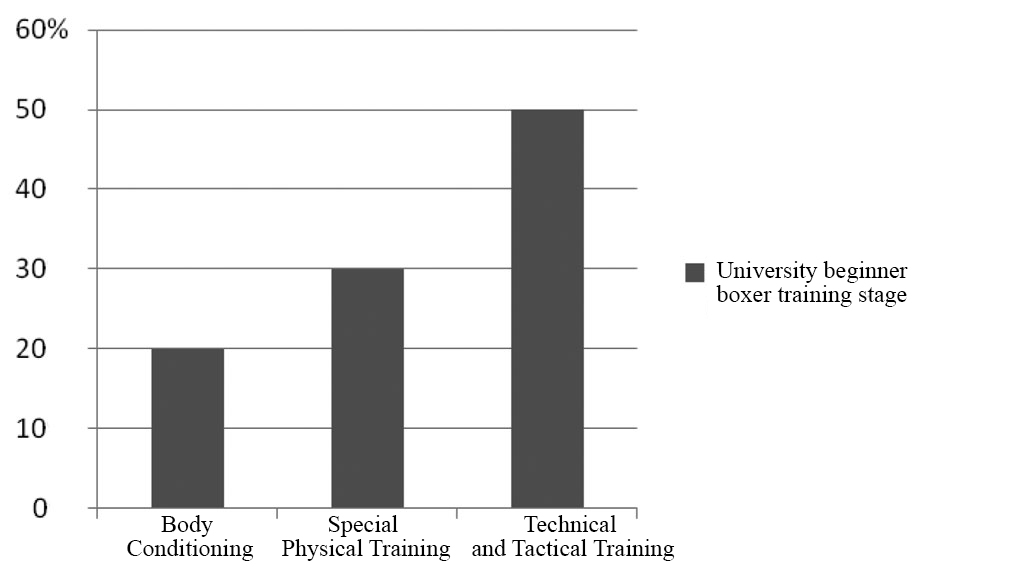Technical and tactical training system for beginner university boxers
Фотографии:
ˑ:
Applicant A.G. Demidov
Dr.Med., Professor V.Yu. Lebedinskiy
Associate Professor, PhD G.K. Khomyakov
National Research Irkutsk State Technical University, Irkutsk
Keywords: university boxing, technical and tactical skills, coordination abilities, competitive fight simulation, controlled simulation environment
Background. The academic Physical Education curriculum takes 400 hours of training per four academic years at the higher education establishments. Two training sessions per week in the first and second academic years plus one session per week in the third and fourth years are obviously insufficient for a sound success. The relevant training process scheduling standard (as provided by the valid regulatory documents) in application to the traditional beginner group training methodology (see Figure 1 hereunder) assigns 3 training sessions per week per 2 academic years. The existing time limitations make it virtually impossible to speed up the beginner training (BT) and the technical and tactical training (TTT) processes.

Figure 1. Standard academic schedule of traditional beginner training cycle
It should be noted that university students remain highly motivated for sport success and, therefore, there is a high demand for an education methodology giving the means to speed up the education process and make the beginners fit for the practical boxing education and training stage as soon as possible.
The forced beginner training, however, may be of negative effect on the unprepared university students having drawbacks in the technical/ physical fitness and thereby even de-motivate them for boxing sport on the whole. We believe that it is the motor coordination ability workouts that may be applied as a promising practice to improve the tactical and technical skills of the beginner boxers [4, 6, 7].
It should be noted in this context that analysis of the existing boxing systems applied at Children’s and Youth Sport Schools (CYSS) never ranks the motor coordination skill training as a separate training component, with the coaches being left to apply it or not on their own discretion. As reported by Y. Sadovskiy [6], over 85% of the coaches polled have never assessed nor purposefully developed the motor coordination skills in their trainees. Therefore, there is a need in a theoretically grounded motor coordination skills development system applicable to beginner boxers entering the technical and tactical skills mastering stage.
Objective of the study was to provide theoretical grounds for the technical and tactical skills mastering methodology applicable to the beginner university boxers.
Methods and structure of the study. An analysis of the available theoretical and practical literature on the subject and the personal coaching experience gave us the means to offer more efficient training process schedules and workouts tailored to the subject age group and rated with the BC (Body Conditioning), SPT (Special Physical Training) and TTT (Technical and Tactical) Training cycles within the standard academic curriculum (see Figure 1), with due provisions for more efficient distribution of the academic material in the TTT cycle (see Figure 2).

Figure 2. New schedule of physical education process for university boxers
We have developed a training methodology for the 17+ university age group based on the motor coordination ability improvement system. Practical application of the system made it possible for the first-year students to master the boxing basics for one academic year being trained twice a week under the standard physical education academic curriculum.
The system is designed based on the simulation, special preparatory and conditioning exercises with increased motor coordination complexity to simulate competitive skills mastering process, with the actual practices being designed to simulate the attacking and counterattacking actions in dynamic sequences and combinations.
The long-distance fight simulation model was found to help develop basic visually controlled counterattacking sensomotor responses to the opponent’s actions of variable complexity levels. Since the attacking actions in boxing are always meant for unexpectedness, the model fights enable the beginners to develop the feel of distance and opponent with an emphasis on the high mobility and dynamic balancing skills. Since the attacking and defense actions in the practices are designed in a game manner, it helps both protect health of the trainees and develop good speed and coordination qualities. The short-distance competitive fight model based on the fight simulation practices with a partner helps develop the relevant boxing responses and the body balancing skills. The practices facilitate the process of the optimal leg positioning skills being developed by the trainees to be used as a basis for the efficient defensive and attacking actions mastered on an individualized basis. The training system facilitates the short-distance defence actions being mastered in a fast and efficient manner.
On the whole, the main objective of the system is to help the trainee master the basics of an intelligent long- and short-distance defense dominated by the gloves- and movement- controlled defense actions. In the arms-controlled defence component, the beginner boxer learns never turn away, never close eyes, never blink and keep distance at all times to avoid being hit, or sensibly take the shots on defence and counterattack.
In the second semester when the first beginner competitions are back, the trainees start mastering the mid-distance defense actions dominated by the trunk movements (back and side movement, dives etc.) and boxing footwork. Generally, the system is designed to train the beginner to act and move sensibly, never turn away, never close eyes, never blink and keep defended by gloves thereby acquiring a practical fighting experience.
Study results and discussion. The beginner training system we have developed made it possible for the first-year students to master boxing basics for one academic year being trained twice a week under the standard physical education academic curriculum. Efficiency of the special practices simulating the competitive fights was rated by the test of the visual-motor analyzer system functionality that is known to play a key role in boxing fights.
Table 2. Central nervous system functioning test data for Study Group vs. Reference Group
|
Group |
Mode, s |
Mode amplitude (MA), % |
0.5 MA interval, ms |
Mid-interval, ms |
FL |
RS |
FPL |
FC |
|
Study Group (SG) |
208,7±0,02 |
42,6±0,04 |
31,6±0,05 |
207,0 ±0,03 |
5,0±0,001 |
2,6±0,001 |
4,2±0,002 |
92,2±0,06 |
|
Reference Group (RG) |
208,1±0,2 |
27,7±0,07 |
70,6±0,4 |
217,5±0,3 |
4,3±0,003 |
1,5±0,006 |
3,0±0,006 |
58,9±0,2 |
Note: FL Functionality level of the CNS; RS response stability rate; FPL functional performance level of the CNS; FR Functional capacity rate of the CNS
We used “Istoki Zdorovya” [“Health Sources”] Test System designed to test the CNS responses to light signals by the subject’s reacting to them by pressing keys on the keyboard, with the response time being metered in milliseconds. Prior to the tests, the Study Group was trained under the innovative training system whilst the Reference Group was trained by the traditional training method.
The new integrated training system in application to the beginner university boxers showed higher efficiency rates as demonstrated by Table 2 data. Mode, which is the most general rate of the central nervous system responses to impacts, was found about the same for the SG vs. RG (208.7±0.02 vs. 208.1± 0.2, respectively). The Mode Amplitude (MA) which is indicative of the most fast and strong responses to impacts showed notable difference in the SG vs. RG (42.6±0.04 vs. 27.7±0.07, respectively). The mid-interval rate characteristic of the nervous impulse travel time was found to be shorter in the SG vs. RG (207.0±0.03 vs. 217.5±0.3, respectively).
The CNS Functionality Level (FL) shows the rate and time band of the CNS responses to outside impacts being generally indicative of the CNS present state and degree of fatigue. The SG vs. RG FL rates were 5.0±0.001 vs. 4.3±0.003, respectively, that means that the SG showed better progress in this test. The Response Stability (RS) rate is characteristic of how stable the maximal response rate with time is; this rate normally sags with fatigue and/or de-normalization of regime. The CNS Functional Performance Level (FPL) was tested to average 4.2±0.002 in the SG that was better than in the RG (3.0±0.006). This rate is generally indicative of the trainees’ level of response and the ability to maintain it for a reasonably long period. The CNS Functional Capacity (FC) rate that is generally indicative of the nervous system exhaustion degree, was rated higher in the SG vs. RG (92.2±0.06 vs. 58.9±0.2, respectively).
Conclusion
The motor coordination development component being included in the standard training system was tested to help balance the excitation and inhibition processes in the central nervous system. The new training system made it possible for the beginner student-boxers to master complex coordinated motor skills in junior age groups with no detriment to their health. The six-years-long comparative experiment proved the new training technology being highly efficient.
References
- Demidov A.G. K voprosu podgotovki studentov-bokserov (Student-boxer training) / A.G. Demidov, G.K. Khomyakov // Vestnik IrGTU (Herald of IrSTU). – 2012. – № 4(63). – P. 219-222.
- Demidov A.G. Tekhniko-takticheskaya podgotovka studentov-bokserov na nachalnom etape trenirovki (Initial technical and tactical training of beginner student-boxer) / A.G. Demidov, V.Yu. Lebedinskiy, G.K. Khomyakov// Teoriya i praktika fiz. kultury. – 2014. – № 8. – P. 40-43.
- Koteshev V.E. Metodicheskie osnovy kontrolya za podgotovlennosti bokserov s ispol'zovaniem trenazherno-izmeritel'nykh sredstv: ucheb. posobie (Methodical basics of monitoring of boxers' fitness by means of training and measurement tools: teaching aid) / V.E. Koteshev. – Krasnodar: Krasnodarskie izvestiya, 1996. – 128 p.
- Lebedinskiy V.Yu. Metodicheskoe i mediko-biologicheskoe soprovozhdenie uchebno-trenirovochnogo protsessa pri podgotovke studentov-bokserov (Methodical and biomedical support of student-boxer training process) / V.Yu. Lebedinskiy, G.K. Khomyakov, A.G. Demidov, L.G. Tsuker // Vestnik IrGTU (Herald of IrSTU). – 2013. – № 1(72). – P. 245-251.
- Panachev V.D. Innovatsionny metod razvitiya koordinatsionnykih sposobnostey studentov vuza (Innovative method of development of coordination abilities in university students) / V.D. Panachev, A.S. Oshchepkov // Uch. zapiski un-ta im. P.F. Lesgafta. – 2008. – № 60 (40). – P. 82-85.
- Sadowski E.O kontseptsiyakh koordinatsionnoy podgotovki v edinoborstvah (Concepts of coordination training in martial arts) / E.O. Sadowski // Chelovek v mire sporta. Novyie idei, tehnologii, perspektiva: tez. dokl. mezhdunar. kongressa. (Man in the world of sports. New ideas, technologies, perspective: book of abstr. Intern. Congress. Moscow, May 23-28, 1998. P. 1. – Moscow: Fizkul'tura, obrazovanie, nauka, 1998. – P. 240-241.
- Taymazov V.A. Znachenie funktsional'noy asimmetrii kak geneticheskiy marker sportivnykh sposobnostey (Functional asymmetry of genetic marker of athletic abilities)/ V.A. Taymazov, S.E. Bakulev // Uch. zapiski un-ta im. P.F. Lesgafta. – 2006. – № 6 (22). – P. 82-88.
- Filippovich V.I. O neobkhodimosti sistemnogo podkhoda k izucheniyu prirody lovkosti (Systematic approach to study nature of mobility) // Teoriya i praktika fiz. kultury. – 1980. – № 2. – P. 49-51.
- Khomyakov G.K. Gimnastika «tsigun» kak faktor vosstanovleniya v skorostno-silovom periode trenirovki sportsmenov (Qigong gymnastics for athlete's recovery in speed-strength training period) / G.K. Khomyakov, L.V. Kosygina, A.G. Demidov, I.M. Utyasheva // Uch. zapiski un-ta im. P.F. Lesgafta. – 2013. – № 7 (101). – P. 161-169.



